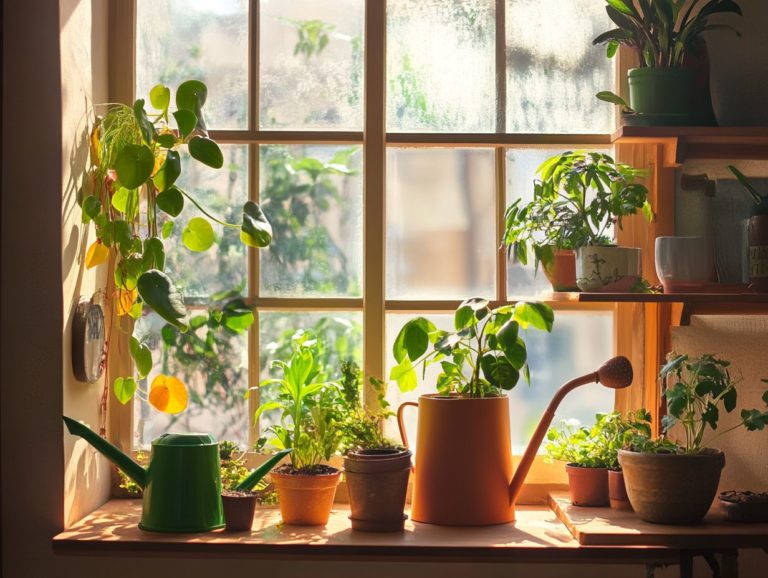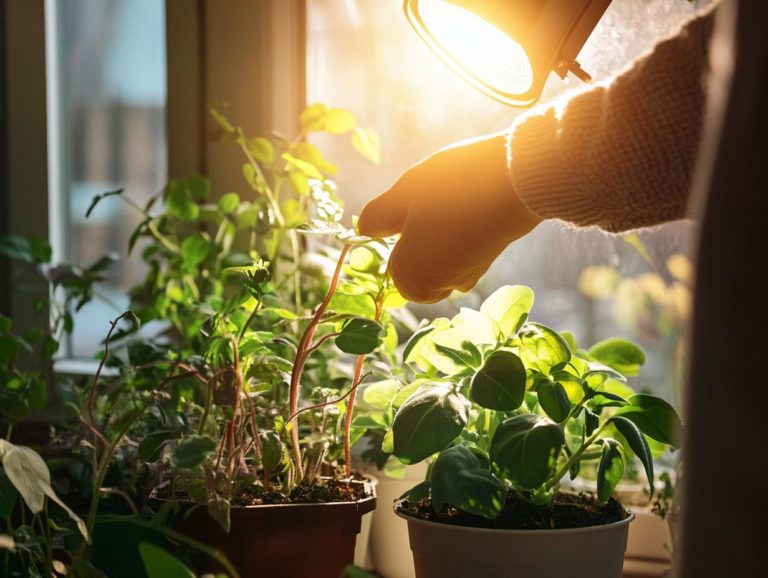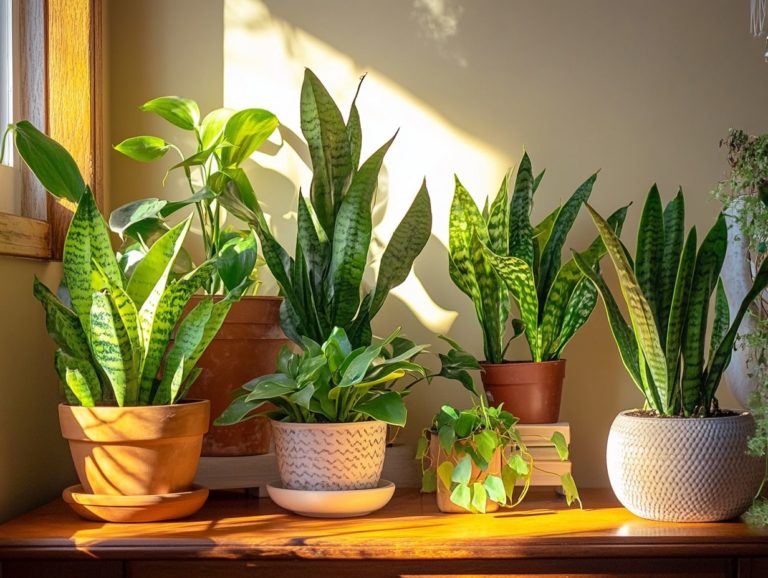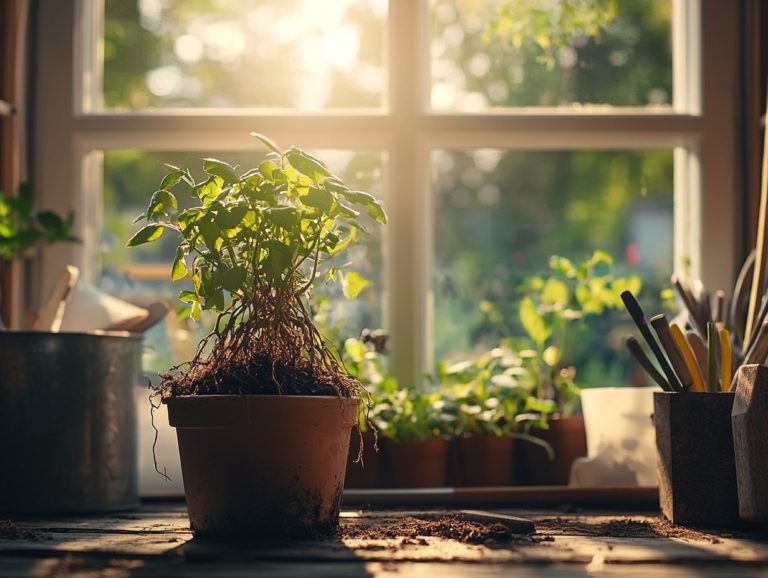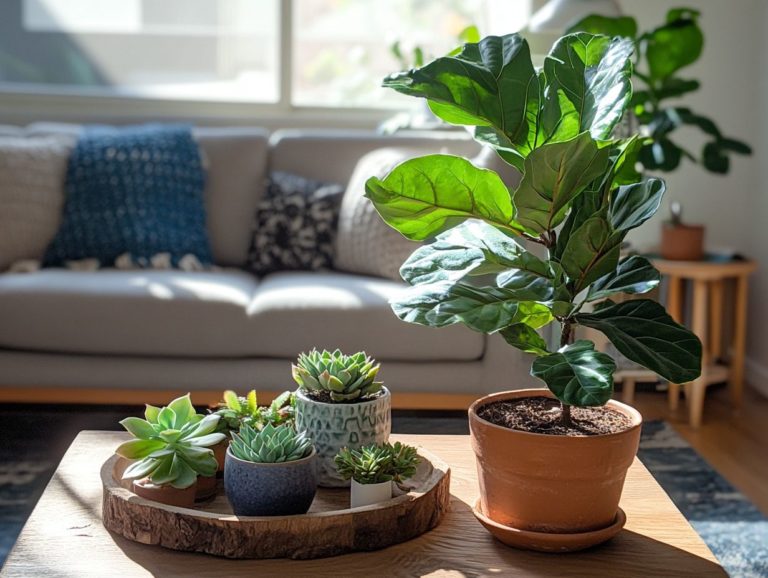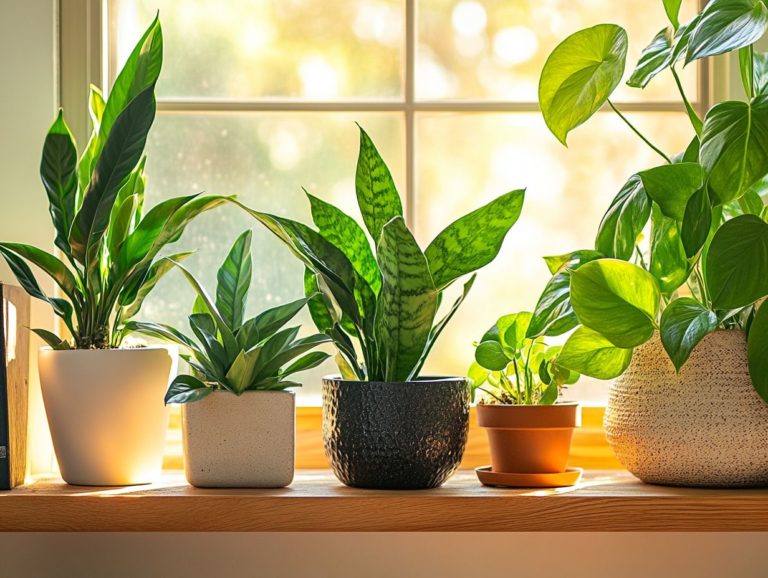What Indoor Plants are Best for Offices?
Indoor plants are not just for decoration. They improve air quality and lower stress levels for employees.
Choosing the right plants is essential as workplaces focus on employee well-being. This article delves into the myriad benefits of indoor plants, outlining key factors to consider when choosing them, and highlighting some of the best options for your workspace.
Moreover, it offers essential care tips to ensure your green companions flourish. Imagine transforming your workspace into a vibrant haven with just a few beautiful plants!
Contents
Key Takeaways:
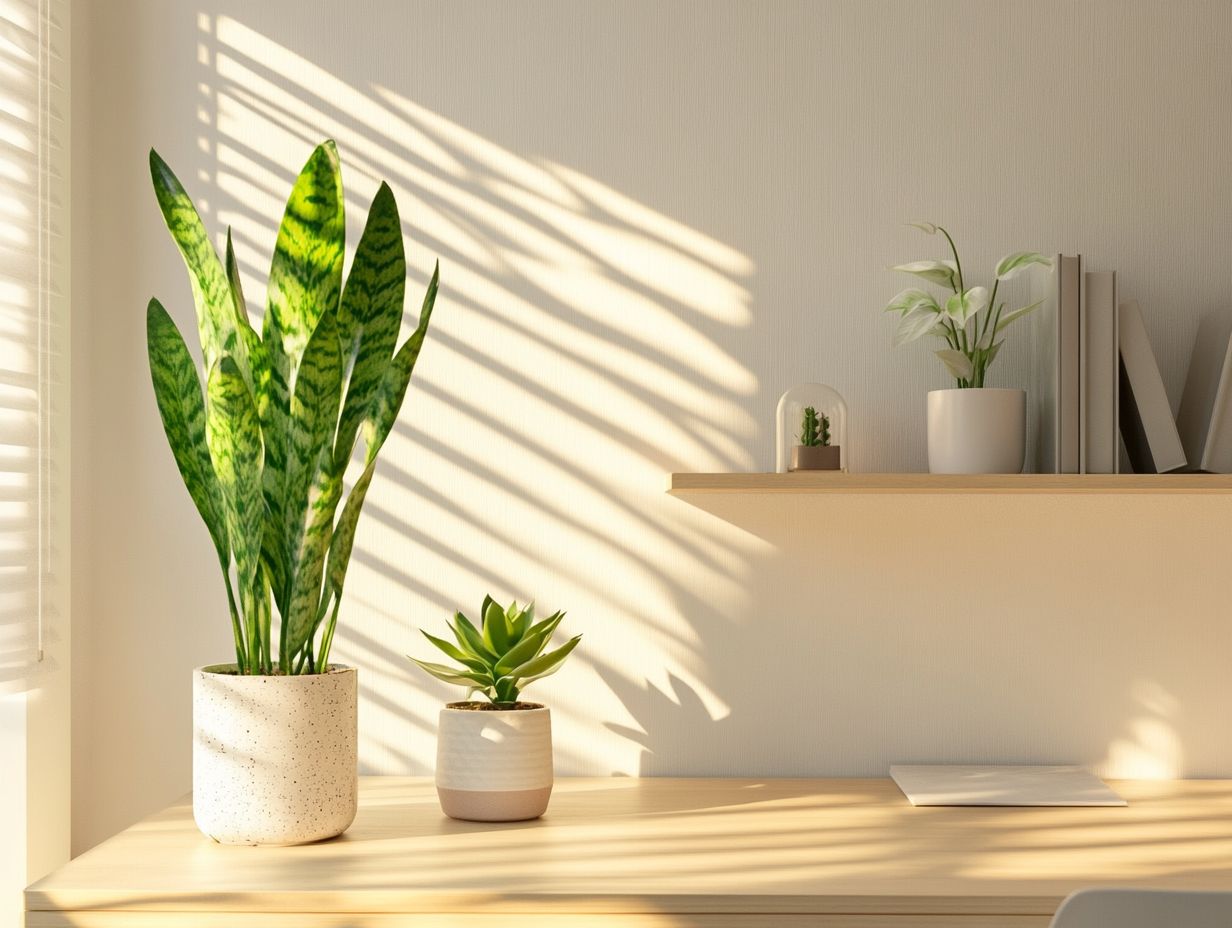
- Indoor plants in offices improve air quality and reduce stress, resulting in a healthier and more productive work environment.
- Look at light and maintenance needs when selecting your office plants. Low-light and low-maintenance options such as snake plants and zz plants are ideal for busy offices.
- Top office plants include peace lilies, spider plants, pothos, and aloe vera. They purify the air and thrive indoors.
Benefits of Indoor Plants in Offices
Incorporating indoor plants into your office space presents a multitude of advantages that elevate the work environment, enhancing both enjoyment and productivity. These plants do more than just beautify; they uplift moods, increase humidity, and significantly purify the air, all while reducing stress levels for everyone on the team.
Choosing low-maintenance varieties means that even those working from home can effortlessly care for them, injecting a touch of vitality and visual appeal that transforms a mundane setting into a flourishing ecosystem.
Improving Air Quality and Reducing Stress
Indoor plants are renowned for their remarkable ability to purify the air, significantly enhancing the quality of your office environment while also alleviating stress levels among employees.
These green companions work their magic through natural processes, absorbing harmful toxins and carbon dioxide, which fosters a healthier indoor atmosphere. Take the peace lily, for instance; it not only eliminates pollutants like formaldehyde and benzene but also introduces a calming aesthetic that can truly elevate your spirits. Then there’s the spider plant, which flourishes in a variety of conditions and excels at filtering out xylene and toluene. For more insights, check out what are the best indoor plants for airflow.
Having these plants around can cultivate a sense of tranquility, ultimately boosting productivity and enhancing overall well-being just the cherry on top of the cleaner air they provide.
Factors to Consider When Choosing Plants for Offices
When you re choosing office plants, it s crucial to take into account several factors that will ensure they thrive in your workspace. Consider aspects like the light conditions, maintenance needs, and the unique characteristics noted on the plant labels, especially those that can be harmful to pets.
This thoughtful approach will help you create an inviting and vibrant environment.
Lighting and Maintenance Requirements
Understanding the lighting and maintenance needs of office plants is essential for their thriving indoors. Choose plants that fit your light conditions to ensure their growth.
Some species, like the snake plant and pothos, thrive in low-light environments. Others, such as the peace lily and fiddle leaf fig, require bright, indirect light, so position them near windows or in well-lit areas.
Watering practices are vital. A deep, thorough soak allows the roots to absorb nutrients while preventing waterlogging, keeping your plants vibrant and healthy.
Top Indoor Plants for Offices
When selecting indoor plants for your office, several standout varieties offer a blend of ease of care, aesthetic charm, and adaptability to diverse conditions.
Consider the snake plant, ZZ plant, peace lily, spider plant, and pothos. Each brings unique benefits, ensuring your workspace remains vibrant and inviting.
Snake Plant

The snake plant, or Sansevieria, is a top choice for your office due to its impressive resilience and ability to clean the air.
This hardy plant thrives in various conditions, making it perfect for busy professionals who may not have time to nurture their greenery regularly. If you’re wondering what is the best indoor plant for beginners, you’ll find it flourishes in low light and can tolerate infrequent watering, adapting to almost any workspace.
Beyond aesthetics, the snake plant enhances indoor air quality by filtering toxins and replenishing oxygen levels. This creates a healthier environment that can elevate your productivity and focus, making it perfect for any workspace.
Its striking vertical leaves instantly elevate your office’s elegance!
ZZ Plant
The ZZ plant is an exceptional choice for your office, especially if you’re looking for a low-maintenance plant that thrives with minimal attention.
With its glossy, deep green leaves and distinctive upward growth, it effortlessly adds an air of elegance to your workspace. This remarkable plant adapts seamlessly to various lighting conditions, thriving in everything from bright, indirect light to those dim corners that often get overlooked.
It’s perfect for busy professionals who need a low-maintenance plant. The ZZ plant also tolerates infrequent watering, so if you forget about it for a while, it will still look great.
Peace Lily
The peace lily is an exquisite choice for your office, celebrated for its stunning white flowers and remarkable ability to purify the air.
This elegant plant thrives in bright, indirect light, making it ideal for office settings where harsh sunlight may be limited. To keep it flourishing, provide consistent moisture while avoiding overwatering, striking that delicate balance that promotes growth. If you’re curious about more options, check out what are the most resilient indoor plants for your space.
Beyond its visual charm, the peace lily is renowned for its air-purifying properties, removing pollutants and fostering a healthier workspace. With its lush green foliage and striking blooms, it serves as a functional addition and a captivating centerpiece. To ensure its vitality and enhance your office ambiance, consider following the best practices for indoor plant care.
Spider Plant
The spider plant stands out for its rapid growth and adaptability to various indoor conditions. It s an ideal choice for your office environment.
Its long, arching leaves create a stunning display that can elevate your workspace. Additionally, its air-purifying qualities contribute to a healthier atmosphere.
This resilient plant thrives with minimal care and flourishes in indirect sunlight. It easily bounces back from occasional neglect.
Propagation, or making new plants, is a breeze; simply snip off the plantlets and place them in soil or water. This allows you to create vibrant new additions to your office.
By incorporating a spider plant, you’re not just beautifying your space; you re also enhancing air quality, which helps eliminate harmful pollutants and promotes employee well-being and productivity.
Pothos
Pothos, often celebrated for its vibrant, trailing vines, is the quintessential office plant that is great at cleaning the air.
This resilient beauty thrives in a range of lighting conditions, transitioning effortlessly from bright, indirect sunlight to low-light spaces.
Its heart-shaped leaves can vary from deep green to delightful variegated hues, bringing a refreshing splash of color to your workspace.
The simplicity of caring for Pothos appeals to both plant novices and seasoned aficionados alike.
Beyond its visual charm, having this lush foliage around significantly enhances indoor air quality by filtering out toxins. This creates a healthier atmosphere for everyone nearby.
Dracaena
Dracaena is a captivating genus of office plants, renowned for their striking foliage and remarkable ability to thrive in low light environments.
With a plethora of species at your fingertips, these plants can cater to your unique aesthetic preferences. For example, Dracaena marginata has slender, arching leaves that lend a modern flair.
In contrast, Dracaena fragrans, commonly known as the corn plant, exudes more classic charm.
Each variety not only enhances your decor but also possesses impressive air purification qualities, effectively filtering out toxins like formaldehyde and benzene.
Understanding their growth habits such as light and water requirements ensures their optimal health, allowing these resilient plants to flourish and contribute to a vibrant and productive office atmosphere.
English Ivy
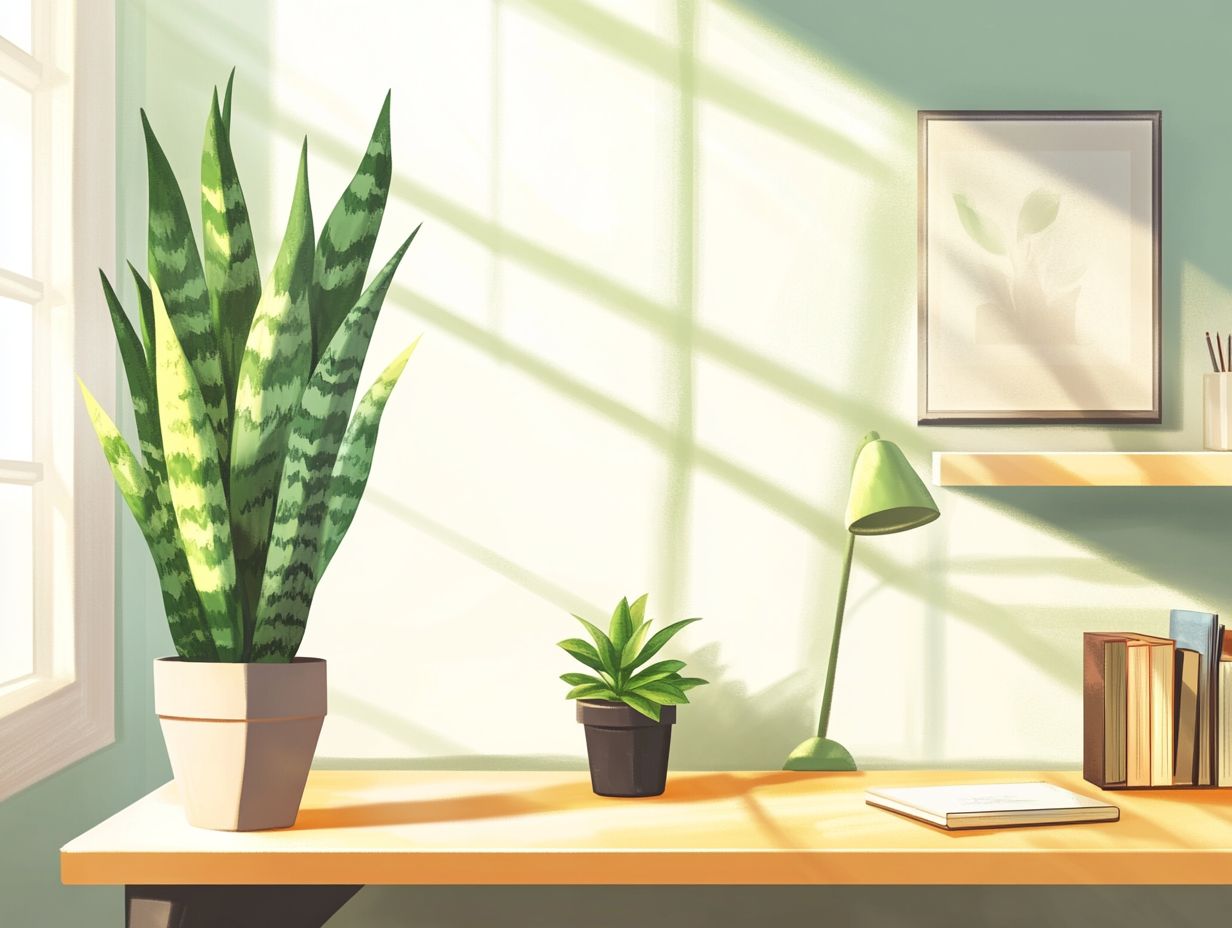
English ivy is the star of indoor plants! It infuses your space with lush greenery and excels at purifying the air, making it an exceptional choice for your office environment.
This adaptable plant flourishes in a variety of light conditions, from low light to bright indirect light. It seamlessly fits into diverse office settings.
English ivy thrives in well-draining soil and appreciates moderate humidity, easily maintained by misting its leaves from time to time.
Regular pruning will encourage a fuller, more vibrant growth, while its trailing vines create a visually striking aesthetic, perfect for enhancing your desk or wall displays.
With its impressive ability to filter toxins from the air, English ivy elevates the quality of your workspace. It cultivates a serene atmosphere that can effectively boost your productivity.
Act now! With minimal care, English ivy transforms into a stunning centerpiece in your office.
Philodendron
The philodendron is an excellent choice for your office, known for its easy-going nature and adaptability to various indoor conditions.
With a stunning array of varieties at your fingertips, it can effortlessly complement any workspace aesthetic.
Whether you re drawn to the heartleaf philodendron with its lush, cascading vines or prefer the more compact elegance of the imperial green, there s a perfect fit for your space.
This resilient plant thrives in low light and needs minimal watering, making it an ideal companion for busy professionals.
Beyond its aesthetic appeal, the philodendron also works hard to purify the air, filtering out harmful toxins while introducing a refreshing touch of nature.
It s a subtle yet effective way to enhance both creativity and productivity in your daily routine.
Bamboo Palm
The bamboo palm is the perfect indoor plant for you. It combines aesthetic charm with practical benefits. Thriving in low light, it effectively purifies the air. This makes it an excellent choice for your office space.
With its touch of tropical elegance, this resilient plant adapts easily to various office layouts. It thrives in environments bathed in indirect sunlight and demands minimal care. Just occasional watering to keep the soil lightly moist makes it a godsend for busy professionals like you. For those looking to enhance their workspace further, consider exploring the best indoor plants for low light.
Beyond its good looks, the bamboo palm is great at filtering out harmful toxins from the air, significantly enhancing indoor air quality. This natural air purifier not only fosters a healthier workplace but also has the potential to boost employee productivity and morale. If you’re interested in adding greenery to your space, consider learning about the best indoor plants for beginners, making it a smart addition for anyone wanting to create a more inviting atmosphere.
Aloe Vera
Aloe vera isn t just famous for its medicinal benefits; it also serves as a low-maintenance indoor plant that excels at purifying the air.
This resilient succulent thrives in bright, indirect light, making it an ideal companion for your office space that enjoys a bit of sunlight. Remember to let the soil dry out completely between waterings overwatering can lead to root rot.
The many health benefits of aloe vera, such as soothing skin irritations and aiding digestion, elevate its value even further. Its natural ability to absorb toxins also fosters a healthier work environment, ultimately boosting your productivity and well-being in spaces enriched by this versatile plant.
Succulents
Succulents are becoming the go-to choice for office plants due to their low maintenance needs and remarkable ability to thrive indoors.
Among the diverse options, the Aloe Vera stands out, not only for being easy to care for but also for its air-purifying qualities. The Jade Plant is celebrated for its timeless look and alleged luck-bringing qualities, making it a charming addition to your desk.
The Echeveria, with its stunning rosette shape and vibrant hues, effortlessly infuses energy into otherwise sterile work areas. These plants thrive on minimal watering and adapt well to varying lighting conditions. They fit seamlessly into different office settings, enhancing the overall atmosphere and making it more inviting and tranquil. For those looking to improve air quality, it’s worth exploring what are the best indoor plants for air quality.
Tips for Caring for Indoor Plants in Offices
Caring for indoor plants in office settings requires attention to their specific needs. This includes how to water them properly and maintaining a watchful eye for pests and diseases.
By embracing these practices, you can create a thriving green oasis that enhances your workspace.
Watering and Fertilizing

Effective watering and fertilizing practices are crucial for maintaining thriving plants in your office environment.
When you ensure that your plants receive deep watering, which means giving them enough water to soak through the soil, you encourage their roots to grow stronger and delve deeper into the soil. This approach boosts the plant’s resilience and reduces how often you need to water.
Selecting the right type of fertilizer, such as a balanced liquid fertilizer or slow-release granules, can significantly enhance nutrient availability. It s generally wise to fertilize every 4 to 6 weeks during the growing season, adjusting as needed based on your plants’ requirements. This thoughtful approach promotes lush foliage and vibrant blooms, ensuring your greenery flourishes beautifully.
Dealing with Pests and Diseases
Dealing with pests and diseases is crucial for plant care. This ensures your indoor plants thrive and look vibrant.
Identifying the early signs of trouble can save your cherished greens from potential harm. Common pests, such as aphids and spider mites, often reveal their presence through visible signs like sticky residue or tiny webs. For effective management, it s wise to regularly inspect the leaves and stems of your plants.
By maintaining optimal humidity and airflow, you can naturally deter those unwelcome visitors. When symptoms occur, a blend of neem oil treatments and insecticidal soap can work wonders. Neem oil is a natural pesticide made from the seeds of the neem tree.
Additionally, issues like root rot may necessitate allowing the soil to dry out and repotting if needed. By staying vigilant, you can protect your plants and savor their beauty for a longer time. Act quickly! Identifying pests early can save your plants and keep them looking their best.
Frequently Asked Questions
What Indoor Plants are Best for Offices?
There are several great options for office plants. Some of the best include spider plants, pothos, peace lilies, and succulents.
Do Indoor Plants Really Improve Office Environment?
Yes, indoor plants have been proven to improve air quality, reduce stress levels, and increase productivity in office environments.
How Often Should I Water My Office Plants?
The frequency of watering depends on the type of plant. Most office plants should be watered once a week and checked for dryness in between.
Can Office Plants Help Reduce Noise in Open Plan Offices?
Yes, certain types of office plants, such as rubber plants, can help absorb sound and reduce noise levels in open plan offices.
What Are Some Low-Maintenance Office Plants?
If you’re looking for low-maintenance options, consider snake plants, ZZ plants, or cacti. These plants require minimal watering and care.
Are There Any Office Plants That Can Thrive in Low Light?
A few options for office plants that can survive in low light environments include peace lilies, ZZ plants, and dracaena.
Take charge of your indoor garden today! Your plants will thank you.

